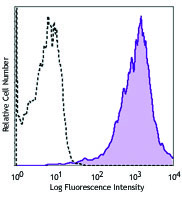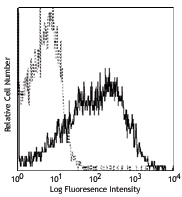- Regulatory Status
- RUO
- Other Names
- CD44 (HCAM), E-cadherin (CD324), ICAM-1 (CD54), VE-cadherin (CD144), P-selectin (CD62P), VCAM-1 (CD106), E-selectin (CD62E), PECAM-1 (CD31), L-selectin (CD62L), EpCAM (CD326), ALCAM (CD166)
- Ave. Rating
- Submit a Review
- Product Citations
- publications
Cell adhesion is the ability of a cell to stick to either another cell or the extracellular matrix. As a form of cell communication, the process plays an important role in cell regulation as well as tissue development and maintenance. A great deal of literature research demonstrates how coordination of these molecules and any potential disruption can be observed in cancers, particularly tumor invasion and metastasis, arthritis, osteoporosis and atherosclerosis. Therefore, understanding cell adhesion can provide insight into disease mechanisms and corresponding treatments.
The LEGENDplex™ Mouse Adhesion Molecule Panel is a multiplex bead-based assay, using fluorescence–encoded beads suitable for use on various flow cytometers. This panel allows simultaneous quantification of 11 mouse adhesion molecules, including CD44, E-cadherin, ICAM-1, VE-cadherin, P-selectin, VCAM-1, E-selectin, PECAM-1, L-selectin, EpCAM, ALCAM. This assay panel provides higher detection sensitivities and broader dynamic ranges than traditional ELISA methods. The panel has been validated for use on serum, plasma and cell culture supernatant samples.
A LEGENDplex™ Mix and Match system is available to customize assays for specificities within this Mouse Adhesion Molecule Panel.
Kit Details
- Kit Contents
-
- Setup Beads: PE Beads
- Setup Beads: Raw Beads
- LEGENDplex™ Mouse Adhesion Molecule Panel Premixed Beads
- LEGENDplex™ Mouse Adhesion Molecule Panel Detection Antibodies
- LEGENDplex™ Mouse Adhesion Molecule Panel Standard
- LEGENDplex™ Lyophilized Standard Reconstitution Buffer
- LEGENDplex™ SA-PE
- LEGENDplex™ Assay Buffer
- LEGENDplex™ Wash Buffer, 20X
- Plate Sealers
- Filter Plate
- Materials Not Included
-
- Flow Cytometer
- Pipettes and Tips
- Reagent Reservoirs for Multichannel Pipettes
- Polypropylene Microfuge Tubes
- Vortex Mixer
- Sonicator
- Aluminum Foil
- Absorbent Pads or Paper Towels
- Plate Shaker
- Tabletop Centrifuges
- A Vacuum Filtration Unit and a Vacuum Source (if using filter plates)
- 1.1 mL polypropylene micro FACS tubes, in 96-tube rack
Product Details
- Verified Reactivity
- Mouse
- Application
-
Multiplex - Panel
Learn more about LEGENDplex™ at biolegend.com/legendplex
Download the LEGENDplex™ software here.
Antigen Details
- Gene ID
- 12505 View all products for this Gene ID 12550 View all products for this Gene ID 15894 View all products for this Gene ID 12562 View all products for this Gene ID 20344 View all products for this Gene ID 22329 View all products for this Gene ID 20339 View all products for this Gene ID 18613 View all products for this Gene ID 20343 View all products for this Gene ID 17075 View all products for this Gene ID 11658 View all products for this Gene ID
Related Pages & Pathways
Pages
Related FAQs
- If I don't have a vacuum, how do I remove the liquid from my plate?
-
If you do not have a vacuum, the assay should be run in a V-bottom plate. After centrifugation using a swinging-bucket rotor with a plate adaptor, you can remove the liquid by flicking the plate quickly, dumping the contents into a sink, and patting it dry carefully on a stack of clean paper towels without losing the beads. Alternatively, you can remove the liquid by using a pipette.
- Should I perform the assay with the filter plates or with V-bottom plates?
-
Filter plates or V-bottom plates have been included in some kits for your convenience. A vacuum filtration unit is required to work with the filter plates. However, if you don’t have access to a vacuum manifold or if you prefer, then you can use the V-bottom plates and follow the recommended assay protocols for the type of plates you choose. All plates should be made from low binding polypropylene. Polystyrene ELISA or cell culture plates should not be used.
- After I finish the staining process, how long can I wait before reading my LEGENDplex™ samples?
-
The samples can be kept overnight at 4°C while being protected from exposure to light and be read the next day. There may be a decrease in signal, but overall, the assay results should not be affected. Storing the samples for extended periods of time is not recommended, as it could lead to further reductions in signal.
- What is the shelf life of LEGENDplex™ kits?
-
LEGENDplex™ kits are guaranteed for 6 months from the date of receipt, but may have a shelf life of up to 2 years from the date of manufacture.
- Is special software required for data analysis?
-
Typically flow cytometers generate output files in FCS format (e.g. FCS 2.0, 3.0, or 3.1) and in some cases in list mode file format (LMD). Other software may be available to analyze FCS files. Data generated using LEGENDplex™ kits can be analyzed using the freely available LEGENDplex™ data analysis software. Please check our website for the most updated versions of the software.
Customers Also Purchased




 Login / Register
Login / Register 








Follow Us